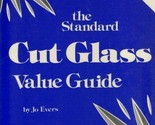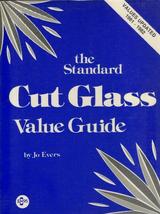Rendered at 09:16:56 11/02/25
Sign up and get $5.00 bCredits free to use at checkout and another $5.00 bCredits when you make your first purchase. More info
Envío gratis
The Standard Cut Glass Value Guide 1981-1982 Update
$73.25 MXN
(It may be possible to pay only $3.45 instead of $3.95 when you
use your bCredits at checkout)
Sign up and get $5.00 bCredits free to use at checkout and another $5.00 bCredits when you make your first purchase. More info
Los buques de
United States

Share & earn! Sign in, share this or any listing, and you’ll get commission when it sells.
Learn more
Las opciones de envío
No hay precio de envío se especifica en MX
Los buques de
United States

Política de oferta
OBO - El vendedor acepta ofertas en este artículo.
Detalles
La política de devoluciones
Protección de compra
Opciones de pago
PayPal accepted
PayPal Credit accepted
Venmo accepted
PayPal, MasterCard, Visa, Discover, and American Express accepted
Maestro accepted
Amazon Pay accepted
Nuvei accepted
Las opciones de envío
No hay precio de envío se especifica en MX
Los buques de
United States

Política de oferta
OBO - El vendedor acepta ofertas en este artículo.
Detalles
La política de devoluciones
Protección de compra
Opciones de pago
PayPal accepted
PayPal Credit accepted
Venmo accepted
PayPal, MasterCard, Visa, Discover, and American Express accepted
Maestro accepted
Amazon Pay accepted
Nuvei accepted
Rasgos del artículo
| Categoría: | |
|---|---|
| cantidad disponible: |
Sólo uno en stock, para muy pronto |
| Condition: |
Very Good |
| ISBN: |
ISBN-13: 9780891450023 ISBN-10: 0891450025 |
| Author: |
Bill Edwards |
| Book Title: |
The Standard Cut Glass Value Guide 1981-1982 Update |
| Format: |
paperback |
| Publication Year: |
1981 |
Detalles del anuncio
| Envío de descuento: |
Vendedor paga el envío para este artículo. |
|---|---|
| Publicado en venta: |
Más de una semana |
| Artículo número: |
1582867376 |
Descripción del Artículo
The Standard Cut Glass Value Guide 1981-1982 Update
Author: Bill Edwards
ISBN-13: 9780891450023
ISBN-10: 0891450025
Publication Date: 6/1981
Publisher: Collector Books
Paperback
8.3 x 11 inches, 156 pages
Cut glass or cut-glass is a technique and a style of decorating glass. For some time the style has often been produced by other techniques such as the use of moulding, but the original technique of cutting glass on an abrasive wheel is still used in luxury products. On glassware vessels, the style typically consists of furrowed faces at angles to each other in complicated patterns, while for lighting fixtures, the style consists of flat or curved facets on small hanging pieces, often all over. Historically, cut glass was shaped using "coldwork" techniques of grinding or drilling, applied as a secondary stage to a piece of glass made by conventional processes such as glassblowing.
Today, the glass is often mostly or entirely shaped in the initial process by using a mould (pressed glass), or imitated in clear plastic. Traditional hand-cutting continues, but gives a much more expensive product. Lead glass has long been misleadingly called "crystal" by the industry, evoking the glamour and expense of rock crystal, or carved transparent quartz, and most manufacturers now describe their product as cut crystal glass.
There are two main types of object made using cut glass: firstly drinking glasses and their accompanying decanters and jugs, and secondly chandeliers and other light fittings. Both began to be made using the cut glass style in England around 1730, following the development there of a reliable process for making very clear lead glass with a high refractive index. Cut glass requires relatively thick glass, as the cutting removes much of the depth, and earlier clear glass would mostly have appeared rather cloudy if made thick enough to cut. For both types of object, some pieces are still made in traditional styles, broadly similar to those of the 18th century, but other glassmakers have applied modern design styles.
Expensive drinking glasses had previously mostly concentrated on elegant shapes of extreme thinness. If there was decoration it was mostly either internal, with hollow bubble or coloured spirals within the stem ("twists"), or surface decoration in enamelled glass or glass engraving. Outside Venice and Spain, lighting fittings had not previously made much use of glass in Europe; the enamelled mosque lamp of Islamic art was a different matter. But cut glass "drops", faceted in a style derived from gem cutting in jewellery, refracted and spread the light in way that was new, and were enthusiastically embraced by makers and their customers. The main skeleton of the chandelier was very often metal, but this was often all but hidden by a profusion of faceted glass pieces, held in place by metal wire.
Very Good condition - former owner's address label on first page
Added to your wish list!

- The Standard Cut Glass Value Guide 1981-1982 Update
- 1 in stock
- Price negotiable
Get an item reminder
We'll email you a link to your item now and follow up with a single reminder (if you'd like one). That's it! No spam, no hassle.
Already have an account?
Log in and add this item to your wish list.



